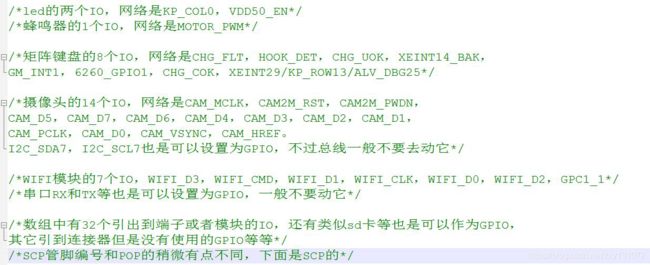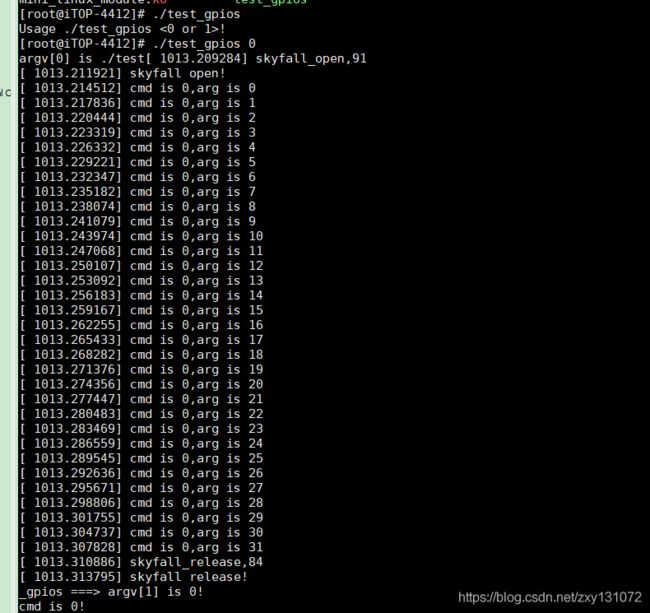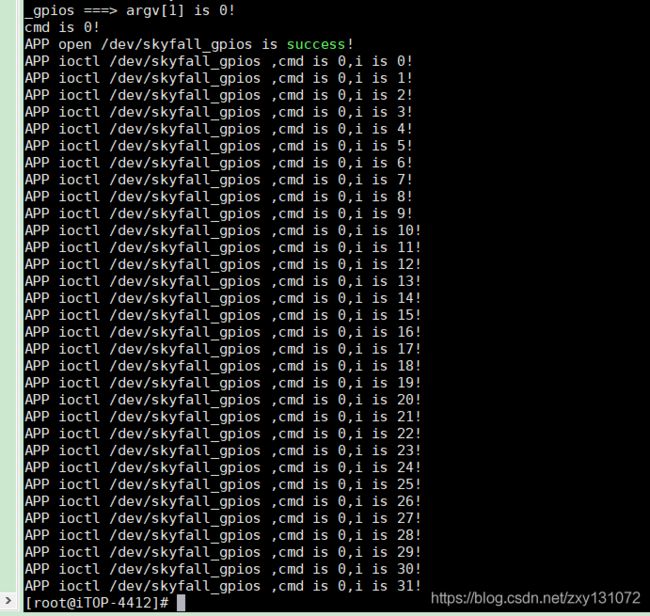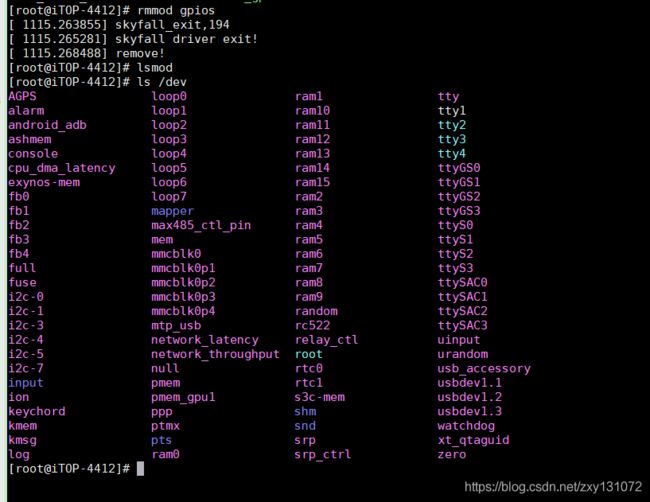013_itop4412设置多个GPIO
一、去掉占用GPIO的驱动
包括 leds,buzzer,camera ov5640,WIFI
/*led的两个IO,网络是KP_COL0,VDD50_EN*/
/*蜂鸣器的1个IO,网络是MOTOR_PWM*/
/*矩阵键盘的8个IO,网络是CHG_FLT,HOOK_DET,CHG_UOK,XEINT14_BAK,
GM_INT1,6260_GPIO1,CHG_COK,XEINT29/KP_ROW13/ALV_DBG25*/
/*摄像头的14个IO,网络是CAM_MCLK,CAM2M_RST,CAM2M_PWDN,
CAM_D5,CAM_D7,CAM_D6,CAM_D4,CAM_D3,CAM_D2,CAM_D1,
CAM_PCLK,CAM_D0,CAM_VSYNC,CAM_HREF。
I2C_SDA7,I2C_SCL7也是可以设置为GPIO,不过总线一般不要去动它*/
/*WIFI模块的7个IO,WIFI_D3,WIFI_CMD,WIFI_D1,WIFI_CLK,WIFI_D0,WIFI_D2,GPC1_1*/
/*串口RX和TX等也是可以设置为GPIO,一般不要动它*/
/*数组中有32个引出到端子或者模块的IO,还有类似sd卡等也是可以作为GPIO,
其它引到连接器但是没有使用的GPIO等等*/
/*SCP管脚编号和POP的稍微有点不同,下面是SCP的*/
static int led_gpios[] = {
EXYNOS4_GPL2(0),EXYNOS4_GPK1(1),
EXYNOS4_GPD0(0),
EXYNOS4_GPX1(0),EXYNOS4_GPX1(3),EXYNOS4_GPX1(5),EXYNOS4_GPX1(6),
EXYNOS4_GPX3(0),EXYNOS4_GPX2(6),EXYNOS4_GPX2(7),EXYNOS4_GPX3(5),
EXYNOS4212_GPJ1(3),EXYNOS4_GPL0(1),EXYNOS4_GPL0(3),EXYNOS4212_GPJ1(0),
EXYNOS4212_GPJ1(2),EXYNOS4212_GPJ1(1),EXYNOS4212_GPJ0(7),EXYNOS4212_GPJ0(6),
EXYNOS4212_GPJ0(5),EXYNOS4212_GPJ0(4),EXYNOS4212_GPJ0(0),EXYNOS4212_GPJ0(3),
EXYNOS4212_GPJ0(1),EXYNOS4212_GPJ0(2),
EXYNOS4_GPK3(6),EXYNOS4_GPK3(1),EXYNOS4_GPK3(4),EXYNOS4_GPK3(0),
EXYNOS4_GPK3(3),EXYNOS4_GPK3(5),EXYNOS4_GPC1(1),
};
1、去掉摄像头驱动VIDEO_OV5640
– Device Drivers
– Multimedia support(MEDIA_SUPPORT [=y])
– Video capture adapters(VIDEO_CAPTURE_DRIVERS [=y])(去掉)
2、去掉WIFI 驱动MTK_COMBO_CHIP_MT662
– Device Drivers
– MediaTek Connectivity Combo Chip Config
– MediaTek Connectivity Combo Chip Support (MTK_COMBO [=y])(去掉)
– Select Chip ( [=y])
# CONFIG_MTK_COMBO is not set
3、去掉leds 的驱动
--Device Drivers
--Character devices
--Enable LEDS config
4、去掉Buzzer 的驱动
--Device Drivers
--Character devices
--Enable BUZZER config
# CONFIG_LEDS_CTL is not set
CONFIG_HELLO_CTL=y
# CONFIG_BUZZER_CTL is not set
5、修改完之后重新编译内核,将新生成的内核二进制文件zImage 烧写到开发板。
二、多个GPIO设置测试源码
1、gpios.c
#include
#include
/*驱动注册的头文件,包含驱动的结构体和注册和卸载的函数*/
#include
/*注册杂项设备头文件*/
#include
/*注册设备节点的文件结构体*/
#include
/*Linux中申请GPIO的头文件*/
#include
/*三星平台的GPIO配置函数头文件*/
/*三星平台EXYNOS系列平台,GPIO配置参数宏定义头文件*/
#include
#include
/*三星平台4412平台,GPIO宏定义头文件*/
#include
#define DRIVER_NAME "skyfall"
#define DEVICE_NAME "skyfall_gpios"
MODULE_LICENSE("Dual BSD/GPL");
MODULE_AUTHOR("SKYFALL");
/*led的两个IO,网络是KP_COL0,VDD50_EN*/
/*蜂鸣器的1个IO,网络是MOTOR_PWM*/
/*矩阵键盘的8个IO,网络是CHG_FLT,HOOK_DET,CHG_UOK,XEINT14_BAK,
GM_INT1,6260_GPIO1,CHG_COK,XEINT29/KP_ROW13/ALV_DBG25*/
/*摄像头的14个IO,网络是CAM_MCLK,CAM2M_RST,CAM2M_PWDN,
CAM_D5,CAM_D7,CAM_D6,CAM_D4,CAM_D3,CAM_D2,CAM_D1,
CAM_PCLK,CAM_D0,CAM_VSYNC,CAM_HREF。
I2C_SDA7,I2C_SCL7也是可以设置为GPIO,不过总线一般不要去动它*/
/*WIFI模块的7个IO,WIFI_D3,WIFI_CMD,WIFI_D1,WIFI_CLK,WIFI_D0,WIFI_D2,GPC1_1*/
/*串口RX和TX等也是可以设置为GPIO,一般不要动它*/
/*数组中有32个引出到端子或者模块的IO,还有类似sd卡等也是可以作为GPIO,
其它引到连接器但是没有使用的GPIO等等*/
static int led_gpios[] = {
EXYNOS4_GPL2(0),EXYNOS4_GPK1(1),EXYNOS4_GPD0(0),
EXYNOS4_GPX1(0),EXYNOS4_GPX1(3),EXYNOS4_GPX1(5),EXYNOS4_GPX1(6),
EXYNOS4_GPX3(0),EXYNOS4_GPX2(6),EXYNOS4_GPX2(7),EXYNOS4_GPX3(5),
EXYNOS4212_GPJ1(3),EXYNOS4_GPL0(1),EXYNOS4_GPL0(3),EXYNOS4212_GPJ1(0),
EXYNOS4212_GPJ1(2),EXYNOS4212_GPJ1(1),EXYNOS4212_GPJ0(7),EXYNOS4212_GPJ0(6),
EXYNOS4212_GPJ0(5),EXYNOS4212_GPJ0(4),EXYNOS4212_GPJ0(0),EXYNOS4212_GPJ0(3),
EXYNOS4212_GPJ0(1),EXYNOS4212_GPJ0(2),
EXYNOS4_GPK3(6),EXYNOS4_GPK3(1),EXYNOS4_GPK3(4),EXYNOS4_GPK3(0),
EXYNOS4_GPK3(3),EXYNOS4_GPK3(5),EXYNOS4_GPC1(1),
};
//#define ARRAY_SIZE(x) (sizeof(x) / sizeof((x)[0]))
#define LED_NUM ARRAY_SIZE(led_gpios)
static long skyfall_ioctl( struct file *files, unsigned int cmd, unsigned long arg){
printk("cmd is %d,arg is %d\n",cmd,arg);
//arg为GPIO的数量,一共为32个,需要小于32个.
//cmd为设置GPI的状态,1为将对应的GPIO设置为高电平,0为将对应的GPIO设置为低电平.
switch(cmd)
{
case 0:
case 1:
if (arg > LED_NUM) {
return -EINVAL;
}
gpio_set_value(led_gpios[arg], cmd);
break;
default:
return -EINVAL;
}
gpio_set_value(led_gpios[2], 0);
return 0;
}
static int skyfall_release(struct inode *inode, struct file *file){
printk("%s,%d\n",__func__,__LINE__);
printk(KERN_EMERG "skyfall release!\n");
return 0;
}
static int skyfall_open(struct inode *inode, struct file *file){
printk("%s,%d\n",__func__,__LINE__);
printk(KERN_EMERG "skyfall open!\n");
return 0;
}
static struct file_operations skyfall_ops = {
.owner = THIS_MODULE,
.open = skyfall_open,
.release = skyfall_release,
.unlocked_ioctl = skyfall_ioctl,
};
static struct miscdevice skyfall_dev = {
.minor = MISC_DYNAMIC_MINOR,
.name = DEVICE_NAME,
.fops = &skyfall_ops,
};
static int skyfall_probe(struct platform_device *pdv){
int ret,i;
printk(KERN_EMERG "initialized\n");
for(i=0; i < LED_NUM; i++)
{
ret = gpio_request(led_gpios[i], "LED");
if (ret)
{
printk("%s: request GPIO %d for LED failed, ret = %d\n", DRIVER_NAME,i, ret);
}
else
{
s3c_gpio_cfgpin(led_gpios[i], S3C_GPIO_OUTPUT);
gpio_set_value(led_gpios[i], 1);
}
}
//单独将蜂鸣器的关掉,为的是不让它开始鸣叫,要不太吵!
gpio_set_value(led_gpios[2], 0);
printk("%s,%d\n",__func__,__LINE__);
ret = misc_register(&skyfall_dev);
if(ret < 0)
{
printk("leds:register device failed!\n");
}
return 0;
}
static int skyfall_remove(struct platform_device *pdv){
int i;
printk(KERN_EMERG "remove!\n");
for(i=0; i < LED_NUM; i++)
{
gpio_free(led_gpios[i]);
}
misc_deregister(&skyfall_dev);
return 0;
}
static void skyfall_shutdown(struct platform_device *pdv){
return ;
}
static int skyfall_suspend(struct platform_device *pdv,pm_message_t pmt){
return 0;
}
static int skyfall_resume(struct platform_device *pdv){
return 0;
}
struct platform_driver skyfall_driver = {
.probe = skyfall_probe,
.remove = skyfall_remove,
.shutdown = skyfall_shutdown,
.suspend = skyfall_suspend,
.resume = skyfall_resume,
.driver = {
.name = DRIVER_NAME,
.owner = THIS_MODULE,
}
};
static int __init skyfall_init(void)
{
int DriverState;
printk("%s,%d\n",__func__,__LINE__);
printk(KERN_EMERG "skyfall driver enter!\n");
printk("LED_NUM = %d\n",LED_NUM);
DriverState = platform_driver_register(&skyfall_driver);
printk(KERN_EMERG "DriverState = %d\n",DriverState);
return 0;
}
static void skyfall_exit(void)
{
printk("%s,%d\n",__func__,__LINE__);
printk(KERN_EMERG "skyfall driver exit!\n");
platform_driver_unregister(&skyfall_driver);
return ;
}
module_init(skyfall_init);
module_exit(skyfall_exit);
2、Makefile文件
#!/bin/bash
$(warning KERNELRELEASE = $(KERNELRELEASE))
ifeq ($(KERNELRELEASE),)
#内核的源码路径, ?= 条件赋值, uname -r 得到内核版本号
KERNELDIR ?= /home/mint/itop/linux_3.0
# := 立即赋值, 得到当前的绝对路径
PWD := $(shell pwd)
# -C 切换工作路径, $(MAKE) = make
modules:
$(MAKE) -C $(KERNELDIR) M=$(PWD) modules
clean:
rm -rf *.o *~ core .depend .*.cmd *.ko *.mod.c .tmp_versions Module* modules*
.PHONY: modules clean
else
# 生成模块
obj-m := gpios.o
endif
3、编译生成的驱动文件
4、将该驱动加载至开发板测试
三、应用层测试GPIO
1、test_gpios.c
#include
#include
#include
#include
#include
#include
#include
#define GPIOS 32
int main(int argc , const char *argv[])
{
int fd,i,cmd=2;
char *leds = "/dev/skyfall_gpios";
char *cmd0 = "0";
char *cmd1 = "1";
if(argc < 2)
{
printf("Usage %s <0 or 1>!\n",argv[0]);
return -1;
}
printf("argv[0] is %s ===> argv[1] is %s!\n",argv[0],argv[1]);
if(strcmp(argv[1], cmd0) == 0)
{
cmd = 0;
printf("cmd is 0!\n");
}
if(strcmp(argv[1], cmd1) == 0)
{
cmd = 1;
printf("cmd is 1!\n");
}
if((fd = open(leds,O_RDWR|O_NDELAY)) < 0)
{
printf("APP open %s is failed!\n",leds);
}
else
{
printf("APP open %s is success!\n",leds);
for(i = 0; i < GPIOS; i++)
{
ioctl(fd,cmd,i);
printf("APP ioctl %s ,cmd is %d,i is %d!\n",leds,cmd,i);
}
}
close(fd);
return 0;
}
2、生成的ELF文件
3、测试
(1)将以上两个文件放到开发板中,加载驱动
insmod gpios.ko
(2)运行ELF文件
./test_gpios
(4)卸载驱动
rmmod gpios
检查一下运行应用之后有没有错误,如果有错误,多半是因为没有将调用对应GPIO的驱动去除,导致GPIO 被占用了。








